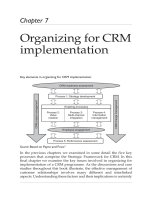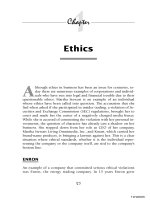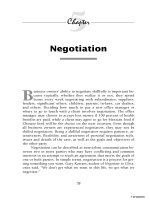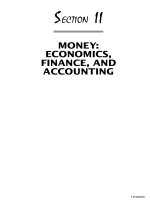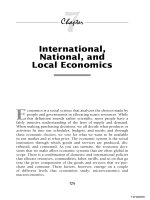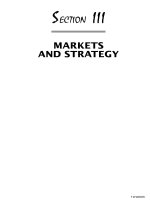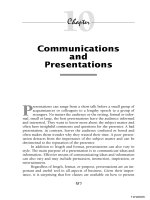MBA In A Day Chapter 7 pot
Bạn đang xem bản rút gọn của tài liệu. Xem và tải ngay bản đầy đủ của tài liệu tại đây (258.87 KB, 19 trang )
7
International,
National, and
Local Economics
E
conomics is a social science that analyzes the choices made by
people and governments in allocating scarce resources. While
this definition sounds rather scientific, most people have a
fairly intuitive understanding of the laws of supply and demand.
When making purchasing decisions, we all decide what products or
activities fit into our schedules, budgets, and needs; and through
these economic choices, we vote for what we want to be available
in our market and at what price. The economic system is the social
institution through which goods and services are produced, dis-
tributed, and consumed. As you can surmise, the economic deci-
sions that we make affect economic systems that are often global in
scope. There is a combination of domestic and international policies
that allocate resources, commodities, labor, tariffs, and so on that go
into the price composition of the goods and services that we pur-
chase and consume. These factors, however, emerge on a couple
of different levels that economists study: microeconomics and
macroeconomics.
Chapter
124
ccc_stralser_ch07_124-142.qxd 7/22/04 9:05 AM Page 124
TLFeBOOK
MICROECONOMICS AND MACROECONOMICS
Microeconomics is the study of small economic units such as indi-
vidual consumers, families, and businesses. It is the study of the
individual parts of the economy and how prices are determined and
how prices in turn determine the production, distribution, and use
of goods and services. Macroeconomics refers to the study of a coun-
try’s overall economic issues. Although these two disciplines are
often addressed separately, they are interrelated, as macroeconomic
issues help shape the decisions that affect individuals, families, and
businesses.
Another area of economics focuses on the global impact of emerg-
ing markets. The financial markets of developing economies in Asia
such as China, India, Indonesia, Malaysia, South Korea, Taiwan, and
Thailand are among the most important. In Latin America, Argentina,
Brazil, Chile, Colombia, Mexico, Peru, and Venezuela are also demon-
strating large amounts of economic/financial activity. Africa has five
countries considered emerging markets in the international arena:
Ghana, Ivory Coast, Kenya, Nigeria, and South Africa. In Europe, the
Czech Republic, Greece, Hungary, Poland, Portugal, Russia, and
Turkey are all markets that are striving toward the financial stability of
the European Union (EU).
SUPPLY AND DEMAND
The basic relationships in the study of economic systems are the fac-
tors that drive the forces of these economies: supply and demand.
Supply refers to the willingness and ability of sellers to provide goods
and services for sale at different prices. Demand refers to the willing-
ness and ability of buyers to purchase goods and services at different
prices.
Factors Driving Demand
The study of economics focuses on the “wants” of the players in a
market and the limited financial resources that they have to spend
on their wants. The dynamics between supply and demand can be
International, National, and Local Economics
125
ccc_stralser_ch07_124-142.qxd 7/22/04 9:05 AM Page 125
TLFeBOOK
best understood when looking at a demand curve. Demand is de-
fined as the relationship between the price of the good and the
amount or quantity the consumer is willing and able to purchase in
a specified time period, given constant levels of the other determi-
nants—tastes, income, prices of related goods, expectations, and
number of buyers. The graph of the demand curve demonstrates the
amount of product that buyers will purchase at different prices. Typ-
ically demand rises as the price of a product falls and demand de-
creases as prices rise. The sensitivity of the changes in price and
demand is called price elasticity.
Products and services have different degrees of price elasticity.
For example, if gasoline increases in price, overall demand may not be
proportionately reduced (i.e., a low degree of price elasticity), as peo-
ple still need gas to fuel their vehicles (assuming there are no substi-
tutes or alternatives—for example, a move toward using public
transportation). If, however, the price of airline travel increases greatly,
it may be likely that demand for air travel will have a greater than pro-
portionate decline. This means that there is a relatively high degree of
price elasticity.
Businesses need to carefully monitor the factors that may affect
demand. If they aren’t keeping a careful eye on these different demand
elements as related to their business, assuredly their competitors will
find a competitive advantage that can affect an organization’s long-
term survival.
Factors Driving Supply
The supply aspect of an economic system refers to the relationship
between different prices and the quantities that sellers will offer:
Generally, the higher the price, the more of a product or service that
will be offered.
The law of supply and demand states that prices are set by the in-
tersection of the supply and the demand. The point where supply and
demand meet identifies the equilibrium price, or the prevailing market
price at which you can expect to purchase a product. All of these fac-
tors of supply and demand, then, come down to setting a price for the
product or service that the market will bear.
MONEY: ECONOMICS, FINANCE, AND ACCOUNTING
126
ccc_stralser_ch07_124-142.qxd 7/22/04 9:05 AM Page 126
TLFeBOOK
ECONOMIC SYSTEMS
In the twentieth century, there were primarily two competing eco-
nomic systems that provided answers to the questions of what to pro-
duce and for whom, given limited resources: “command economies”
directed by a centralized government and “market economies” based
on private enterprise. History has proven that, worldwide, the central
command-economy model has not sustained economic growth and has
not provided long-term economic security for its citizens.
Private Enterprise
In fact, many government-controlled economies are turning to privati-
zation to improve incentives and efficiency. Privatization is the selling
of government-owned businesses to private investors. This trend has
provided an opportunity for U.S. firms to own businesses in foreign
countries that previously prohibited U.S. investment. Why is this trend
appearing? We will take a look at the four different types of market
structures that are currently identified in the private enterprise system.
The private enterprise system, or market economy, is centered on
the economic theory/belief/philosophy of capitalism and competition.
Capitalism is an economic system in which businesses are rewarded
for meeting the needs and demands of consumers. It allows for private
ownership of all businesses. Entrepreneurs, desiring to earn a profit,
create businesses that they believe will serve the needs of the con-
sumers. Capitalist countries offer foreign firms opportunities to com-
pete without excessive trade barriers.
As a result of the ineffectiveness of command economies, govern-
ments tend to favor the hands-off attitude toward controlling business
ownership, profits, and resource allocations that go along with capital-
ism and market economies with competition regulating economic life
and creating opportunities and challenges that businesses must handle
to succeed.
A Taxonomy of Competition. There are four different types of
competition in a private enterprise system: pure competition, monopo-
listic competition, oligopolies, and monopolies.
International, National, and Local Economics
127
ccc_stralser_ch07_124-142.qxd 7/22/04 9:05 AM Page 127
TLFeBOOK
Pure competition is a market or industry in which there are many
competitors. It is easy to enter the market, as there are few barriers to
entry and many people/organizations are able to offer products that are
similar to each other. In a market where there is pure competition, a
lower price becomes the key factor and leads buyers to prefer one
seller over another, and there is likely to be little differentiation be-
tween products. Additionally, the amount that each individual seller
can offer constitutes such a small proportion that when acting alone it
is powerless to affect the price. Therefore, individual firms in these
commodity-like markets have very little control over the price.
Monopolistic competition means that there are fewer competi-
tors, but there is still competition. In this market environment, it is
somewhat difficult to enter the market. The barriers to entry could
be due to location, access to commodities, technology, or capital in-
vestment levels. The result is that there are usually differences in
products offered by competing firms; perhaps they serve the same
function, but there are differentiations that rely on consumer prefer-
ences to make a choice. Due to the differentiation factor, individual
firms are able to have some sort of control over the prices. They can
choose to charge a premium or a discount to set their product apart
and affect the demand.
Oligopoly is a market situation with few competitors. The few
competitors exist due to high barriers to entry, and a few large sellers
vie for, and collectively account for, a relatively large market share.
The products or services in this market may be similar (telephone
companies) or they may be different (supermarkets). In the oligopo-
listic market situation, the individual firms do have some control
over prices (Whole Foods Market can charge more for produce/prod-
ucts than Albertsons) and can create differentiation or vie for more of
the market share by having price be part of their consumer acquisi-
tion strategy.
Unlike the board game, a monopoly exists in the private enter-
prise system when there is absolutely no other competition. That
means that there is only one provider that exists to provide a good or
service. In this case, it is often the government that regulates who can
enter the market, so there are no specific barriers to entry. But the gov-
ernment regulations ensure that there are no competing products or
services in the market. The lack of competition yields considerable
MONEY: ECONOMICS, FINANCE, AND ACCOUNTING
128
ccc_stralser_ch07_124-142.qxd 7/22/04 9:05 AM Page 128
TLFeBOOK
power over prices in a pure, or unregulated, monopoly, but there is lit-
tle control over prices in a regulated monopoly. An example of a pure
monopoly is the issuance of a patent for a drug, in the case of a phar-
maceutical company. Some pharmaceutical drugs have no current sub-
stitute, in which case the patent holder pharmaceutical company has a
monopoly in the production/distribution of that drug. In this case the
government guarantees that no other company can produce the drug,
and that provides a sufficient market entry barrier. Monopolies of this
sort, however, arise rarely because pharmaceutical drugs may have
substitutes and the regulatory barriers to entry are typically temporary
(for a period of a few years).
Planned Economies
In addition to the private enterprise system, planned economies are an-
other market structure in the world economy. In a planned economy,
government controls determine business ownership, profits, and re-
source allocation. Countries that existed with planned economies,
however, have not been highly successful.
The most common theory of a planned economy is communism,
which purports that all property is shared equally by the people in a
community under the direction of a strong central government. It is an
economic system that involves public ownership of businesses. Rather
than entrepreneurs, the government decides what products consumers
will be offered and in what quantities. As the central planner, the gov-
ernment establishes trade policies that historically have been very re-
strictive in allowing foreign companies the opportunity to compete.
Communism was proposed by Karl Marx and developed and imple-
mented by V. I. Lenin. In Marxist theory, “communism” denotes the fi-
nal stage of human historical development in which the people rule
both politically and economically.
The communist philosophy is based on each individual con-
tributing to the nation’s overall economic success and the country’s re-
sources are distributed according to each person’s needs. The central
government owns the means of production and everyone works for
state-owned enterprises. Further, the government determines what
people can buy because it dictates what is produced.
Looking specifically at China and Russia, we can see what led to
International, National, and Local Economics
129
ccc_stralser_ch07_124-142.qxd 7/22/04 9:05 AM Page 129
TLFeBOOK
the failure of communism. First of all, their constitutions had little or
no meaning, so although the government created laws, they bore no
power. Second, the government owned the means of production and
made all of the economic decisions. Therefore, market forces were not
allowed to work, and the laws of supply and demand were not fol-
lowed. Third, the citizens of these countries had limited rights and all
the citizens were subject to Communist Party control. Individuals ex-
isted to serve the state and had virtually no freedom for themselves. All
of these factors contributed to the downfall of communism and as a re-
sult, China and Russia are currently privatizing and borrowing other
capitalistic methods in an attempt to improve their economic situa-
tions and convert to a more market-based economy. They are desper-
ately trying to get the market to find an equilibrium for their goods
and services that we all too often take for granted.
Socialism
Another economic system is socialism, which is characterized by gov-
ernment ownership and operation of major industries. For example,
when telecommunications, gasoline, or some other major industry is
owned by the government, this is considered a socialistic economy. So-
cialism is an economic system that contains some features of both cap-
italism and communism. Socialist governments allow people to own
businesses and property and to select their own jobs. However, these
governments are involved in providing a variety of public services,
such as generous unemployment benefits, comprehensive health care
for all citizens, and public transit. These public services are paid for by
high tax rates on income. Entrepreneurs, not surprisingly, have less in-
centive to establish businesses if the tax rates are excessively high.
Socialism is based on the belief that major industries are too
important to a society to be left in private hands; however, private
ownership is allowed in industries considered to be less crucial to
social welfare.
As socialism is retreating, there are new theories of regulation
emerging. The new theories aren’t aiming to regulate economic rela-
tions between individuals, as socialism did, but rather they seek to reg-
ulate social relations in general. For example, there is a desire to
MONEY: ECONOMICS, FINANCE, AND ACCOUNTING
130
ccc_stralser_ch07_124-142.qxd 7/22/04 9:05 AM Page 130
TLFeBOOK
increase the “social capital” in communities. If “social capital” is de-
fined as norms and networks that encourage cooperation and trust be-
tween individuals, then the existence of social capital can be beneficial.
It reduces transaction costs, assists the diffusion of knowledge, and can
enhance the sense of community well-being. The questions arising
now, however, are whether the government can create social capital
and, even more fundamental, if the government should create social
capital. Although the traditional form of socialism is no longer touted
as a successful market structure, remnants of it can still be seen in to-
day’s economy.
The majority of market economies that we see today, however,
are mixed market economies. These are economic systems that dis-
play characteristics of both planned and market economies. In the
mixed market economy, government-owned firms frequently oper-
ate alongside private enterprises. Good examples of this can be
found in Europe where the respective governments have tradition-
ally controlled certain key industries such as railroads, banking, and
telecommunications. What is seen today, however, is a trend toward
privatizing many of these state-owned industries. In 1986 the
United Kingdom privatized the gas industry, in 1987 it privatized
the steel industry, and in 1989 water was privatized. Today, Austria
is following suit and is proceeding with the privatization of steel,
oil, and chemicals.
FOUR STAGES OF THE BUSINESS CYCLE
The business cycle, also called the economic cycle, refers to the recur-
ring series of events of expansion, boom, bust, and recession. The
length of business cycles over time are rarely alike. The business cycle
experiences periodic cyclical expansions and contractions in overall
economic activity. For example, the United States has experienced 11
complete business cycles since the end of World War II. Business cy-
cles are relevant because business decisions and consumer buying pat-
terns differ at each stage of the business cycle, and it is important to
know where you are in a business cycle when developing your organi-
zational strategy.
International, National, and Local Economics
131
ccc_stralser_ch07_124-142.qxd 7/22/04 9:05 AM Page 131
TLFeBOOK
Prosperity, or the “boom” part of the business cycle, occurs when
unemployment is low, strong consumer confidence leads to record
purchases and as a result, businesses expand to take advantage of the
opportunities created by the market. A good example of the market ex-
periencing prosperity took place in Silicon Valley from 1998 to 2001.
Suddenly the market identified technology as the next big business op-
portunity, so companies were adopting online technologies at a record
pace; brick and mortar businesses were creating electronic market-
places for the first time. As common sense tells us, no economy can
sustain a boom forever and as we saw in Silicon Valley, a recession, and
sometimes a spot-depression (a short-term slow-down), can follow the
prosperity stage.
A recession is a cyclical economic contraction that lasts for at
least six months. Economists agree that a recession results in a down-
turn lasting for at least two consecutive quarters. During a recession
consumers frequently postpone major purchases, such as homes and
vehicles, and businesses slow production, postpone expansion plans,
reduce inventories, and cut workers. As a result, unemployment rises
and consumer demand decreases.
A depression is classified as a recession, or economic slowdown,
that continues in a downward spiral over an extended period of time.
It is also characterized by continued high unemployment and low con-
sumer spending. Many economists suggest that sufficient government
tools are available to prevent even a severe recession from turning into
a depression. For example, federal, state, and local governments can
make investments to improve the country’s infrastructure as a means of
bringing the market out of a depression. They can invest in transporta-
tion systems and public facilities such as schools and universities, or
perhaps they can loan money to small businesses to help the economy
grow. Governments can also influence the economy through regula-
tions in fiscal and monetary policy, which will be discussed in more de-
tail later in this chapter.
Eventually these tools contribute to the next stage in the business
cycle: recovery. The recovery period is when economic activity begins
to pick up. Consumer confidence improves, which leads to increased
spending on big items such as homes and vehicles. Unemployment
also begins to fall, and people are working and contributing to the
economy again.
MONEY: ECONOMICS, FINANCE, AND ACCOUNTING
132
ccc_stralser_ch07_124-142.qxd 7/22/04 9:05 AM Page 132
TLFeBOOK
THE STABILITY OF A NATION’S ECONOMY
As already discussed, economies are the result of an interrelated mix-
ture of numerous forces.
Productivity
The gross domestic product (GDP) is the value of all goods and ser-
vices produced within a nation’s borders each year. It is a very popular
economic indicator and provides a benchmark for the nation’s overall
economic activity.
Productivity is the relationship between the goods and services
produced and the inputs needed to produce them. During expansion-
ary periods, productivity tends to rise as fewer resources are needed to
produce greater levels of output. During recessions, then, productivity
might stagnate or decrease overall.
Inflation and Deflation
Price-level changes are related to the value of the economy’s currency.
Inflation is a period of rising prices caused by a combination of excess
demand and increases in the costs of the factors of production. “Infla-
tion” is defined as a rise in the general level of prices of goods and ser-
vices over a specified period of time. In the United States, the rate of
inflation is usually measured as the percentage change in the consumer
price index (CPI), which includes the prices of a wide variety of con-
sumer goods and services in categories such as food, clothing, medical
services, housing, and transportation.
Demand-pull inflation occurs when there is an excess of demand
relative to supply. In these conditions, a relative shortage of products
or services gives producers the leverage to increase prices. Cost-push
inflation occurs when there are rises in the costs of the factors of pro-
duction. The costs of either the labor, commodities, or manufacturing
rise and push prices up to cover the increased costs.
Hyperinflation is a period characterized by rapidly rising prices.
We remember the images of people from Communist Russia standing
in long lines to purchase bread because of hyperinflationary costs.
Inflation impacts the economy because more money is needed to
International, National, and Local Economics
133
ccc_stralser_ch07_124-142.qxd 7/22/04 9:05 AM Page 133
TLFeBOOK
sustain a given standard of living. If people receive a fixed income and
suddenly the cost of bread increases dramatically, it is easy to see the
negative impact caused by this increased price.
Inflation can be good news, though, to those who are experienc-
ing a rising income or those with debts at fixed interest rates. Busi-
nesses, however, find it difficult to make long-range plans in high
inflationary conditions, because budgeting and forecasting depend
largely on the prices of products and services needed to conduct busi-
ness. Low inflation, in contrast, makes it easier for businesses to make
long-term plans—it becomes easier to predict prices and costs. Low in-
flation is also associated with low interest rates, encouraging major
purchases by consumers and fueling business expansion.
Deflation is the price-level change referred to during a period of
falling prices. While deflation sounds good, it can have disastrous con-
sequences; the Great Depression was a general period of deflation.
Prices fell, but so did employment and wages for those lucky enough
to be employed, as well as availability of most goods and services.
Relative price levels are measured by two common indicators.
The consumer price index measures the monthly average change in
the prices of a basket of goods and specific services. The producer
price index (PPI) looks at prices from the seller’s perspective (finished
goods, intermediate goods, and crude goods).
Employment Levels
Employment levels have a major impact on a nation’s economy. In fact,
the unemployment rate is one of the most popular economic indicators
that most people intuitively use to understand the state of the econ-
omy. The unemployment rate is usually expressed as the percentage of
total workers who are actively seeking work but are currently unem-
ployed. These indicators tend to increase during recessions and de-
crease during expansions.
Because the unemployment rate is so important, we’re going to
discuss some different categories that have been created to characterize
an economy’s state of unemployment.
Frictional unemployment is when someone is temporarily not
working. A good example is a recent graduate who is looking for work
but has yet to find a job. Seasonal unemployment occurs when people
MONEY: ECONOMICS, FINANCE, AND ACCOUNTING
134
ccc_stralser_ch07_124-142.qxd 7/22/04 9:05 AM Page 134
TLFeBOOK
are not working during some months, but they are not looking for a
job during that period. People involved in the tourism industry or sea-
sonal farmworkers are good examples of this. Structural unemploy-
ment results when people are not working because there is no demand
for their particular skill set. An example might be someone who gradu-
ates with a Ph.D. in medieval economics. There is a relatively low de-
mand for people with this skill set, so structural unemployment results
for many in that field. People who fall into this category, however, may
be training for a new job and developing new skills while they look for
work. Cyclical unemployment results when there is an economic slow-
down and people are looking for work but there aren’t enough jobs.
This was the case for many MBAs who graduated in 2001 and 2002.
The economic recession resulted in fewer jobs, and even highly skilled
graduates with advanced degrees had difficulty finding work.
The unemployment rate does not include the so-called discour-
aged workers, out-of-work people who are no longer looking for jobs.
International Diversification
As a company, one way to mitigate some of these economic uncertain-
ties is to diversify the effects by maintaining markets in two or more
countries. Diversifying into two separate market economies/environ-
ments reduces risks by hedging economic bets across multiple eco-
nomic systems.
Another area in which diversification makes sense for the inter-
national business is in the political risk dimension. Political risk repre-
sents the risk that another country’s political actions may adversely
affect a business. Carried to an extreme, a foreign government may
take over a U.S. firm’s foreign subsidiary without compensating the
U.S. firm. A more common risk is the threat of higher tax rates or re-
strictions on the repatriation of profits to the U.S. parent firm. In gen-
eral, large-scale political events—such as military coups, social unrest,
and currency crises—are referred to as macropolitical risks. Con-
versely, small-scale events—such as expropriation, discriminatory reg-
ulation, and terrorism—are referred to as micropolitical risks.
One of the most basic political risks that you can mitigate is the
fluctuations in exchange rates. Exchange rate risk, or currency risk, is the
risk of an investment’s value changing because of change in the currency
International, National, and Local Economics
135
ccc_stralser_ch07_124-142.qxd 7/22/04 9:05 AM Page 135
TLFeBOOK
exchange rates. For example, a weak dollar is likely to increase both for-
eign sales and profits. These results are due to the lowering of the selling
price of the exported goods, because fewer units of the foreign currency
are now required to purchase U.S made goods or services. A strong dol-
lar is likely to decrease exports and profits. The appreciation of the U.S.
dollar against a foreign currency causes the purchase price of U.S. goods
abroad to increase so that it takes more units of the foreign currency to
buy a given amount of U.S made goods.
Monetary and Fiscal Policy:
Managing an Economy’s Performance
Monetary policy is the regulation of the money supply and interest
rates by a central bank, such as the U.S. Federal Reserve, in order to
control inflation and stabilize currency. In the United States the Fed is
responsible for managing this process. If the economy is heating up,
the Fed can withdraw money from the banking system, raise the re-
serve requirement, or raise the discount rate to make the economy cool
down. This is referred to as a restrictive monetary policy and slows
economic growth. If growth is slowing, the Fed can reverse the
process—increase the money supply, lower the reserve requirement,
and decrease the discount rate. This is referred to as an expansionary
monetary policy, with lower interest rates.
Fiscal policy is the decision that the government makes to spend
money or increase taxes for the specific purpose of stabilizing the
economy. Government increases in spending and lowering of taxes
tend to stimulate economic growth, while decreasing government
spending and increasing taxes tends to slow economic growth. This
makes sense when we think about the individual taxpayer’s disposable
income. The more money individuals have, the more they will be able
to spend on goods and services in the market and therefore stimulate
market growth.
The primary sources of government funds to cover the costs of its
annual budget are raised through taxation of its citizens, fees collected
from business, and borrowing against assets. The U.S. federal budget
has gone from a surplus to a deficit in recent years—it is overspending
its resources. In order to fund this budget deficit, the federal govern-
ment will have to borrow billions of dollars in the coming years.
MONEY: ECONOMICS, FINANCE, AND ACCOUNTING
136
ccc_stralser_ch07_124-142.qxd 7/22/04 9:05 AM Page 136
TLFeBOOK
GLOBAL ECONOMIC CHALLENGES
OF THE TWENTY-FIRST CENTURY
As U.S. economies and policies become increasingly interrelated across
borders and oceans, we face a more complex economic picture. The
opportunities that go along with this more global picture are great, but
so too are the challenges. Cellular telephones, computers, disease-
resistant crops, satellites, biotechnology, and fiber-optic networks are
among the twentieth-century technologies that will shape political, so-
cial, and economic realities well into the twenty-first century—realities
that include the continuing globalization of business, culture, and
health care. So what are the specific challenges that we need to be
aware of?
International Terrorism
Surprise, when it happens to a government, is likely to be a com-
plicated, diffuse, bureaucratic thing. It includes neglect of respon-
sibility but also responsibility so poorly defined or so ambiguously
delegated that action gets lost. It includes gaps in intelligence, but
also intelligence that, like a string of pearls too precious to wear, is
too sensitive to give to those who need it. It includes the alarm
that fails to work, but also the alarm that has gone off so often it
has been disconnected. It includes the unalert watchman, but also
the one who knows he’ll be chewed out by his superior if he gets
higher authority out of bed. It includes the contingencies that oc-
cur to no one, but also those that everyone assumes somebody
else is taking care of. It includes straightforward procrastination,
but also decisions protracted by internal disagreement. It includes,
in addition, the inability of individual human beings to rise to the
occasion until they are sure it is the occasion—which is usually
too late.
The report, Countering the Changing Threat of International Terrorism,
written by the National Commission on Terrorism, begins with these
words by Thomas C. Schelling. In this succinct and clear description of
surprise, the many elements of international terrorism are captured.
Terrorism succeeds because of the element of surprise and, unfortu-
nately, surprise is a factor that we cannot always control.
International, National, and Local Economics
137
ccc_stralser_ch07_124-142.qxd 7/22/04 9:05 AM Page 137
TLFeBOOK
It used to be that international terrorism happened to Americans
only when we were not on our home turf. September 11th, however,
showed us that we are no longer safe within our own borders. Terrorist
attacks are becoming more lethal, too. Most terrorist organizations ac-
tive in the 1970s and 1980s had clear political objectives. They tried
to calibrate their attacks to produce just enough bloodshed to get
attention for their cause, but not so much as to alienate public support.
Today, as we have seen, the objectives are increasingly religious, eco-
nomic, or personal (against an ethnic group) in nature.
In his paper “International Terrorism in the 21st Century,” Frank
Goldstein points out a couple of options to counter the new threats
posed to nations due to international terrorism. One option, which re-
ceived some success after the World Trade Center bombing in 1993, is
the economic incentive or bounty. The U.S. government offered a re-
ward of several million dollars for information leading to the person or
persons responsible for the bombing. An informant in Pakistan pro-
vided the information that led to the arrest of an individual in Islam-
abad, Pakistan, and he was immediately taken to the United States to
await trial.
Although the bounty or reward program seems to have succeeded
in 1993, continued terrorist activity demonstrates that these issues of
international terrorism are very complicated.
A second option for global nation states to thwart terrorism
is “national resolve.” It should be acknowledged that a foolproof
system against terrorism in democratic societies does not exist. Sim-
ple procedures such as better intelligence and improved physical
security of critical sites will, in most cases, deter a particular terror-
ist group.
Economics, technology, and the whims of both criminals and psy-
chotics will produce ongoing and, at times, spectacular events. A result
of terrorism in the United States will be more public and political ef-
forts to counter terrorism by the West. Sadly, terrorism in the third
world and in developing countries will continue almost unabated.
Shift to a Global Information Economy
The information economy is affecting supply chains, digital tech-
nologies, information and communication technologies, technology-
MONEY: ECONOMICS, FINANCE, AND ACCOUNTING
138
ccc_stralser_ch07_124-142.qxd 7/22/04 9:05 AM Page 138
TLFeBOOK
enabled marketing; it is pushing businesses to go wireless, changing
organizational structures, and increasing the value of intellectual
property.
Some think the movement to an information economy is being
oversold as the key to economic opportunity. Information technology
can help people learn how to absorb knowledge generated elsewhere
and combine it with local needs and local knowledge and may help
raise real economic returns on investments, but there are still more fa-
miliar development challenges (e.g., structural unemployment, social
inequality, and an undereducated workforce).
Aging of the World’s Population
The world’s population is getting older and older as a result of drop-
ping fertility rates and urbanization. Europe provides an excellent ex-
ample of how the aging population is changing policy and business.
Fertility rates have plummeted, especially in southern Europe, to the
point that every 10 Italian women are expected to have just 12 chil-
dren in their lifetimes, and every 10 Spanish women just 11. As a
group, the countries of the EU are going to see their populations
shrink, unless they allow significant levels of immigration.
The situation right now is not unique to Europe. In fact, well over
half of the world’s elderly (people aged 65 and older) now live in devel-
oping nations (59 percent in 2000), and this is projected to grow to 71
percent by 2030. Many developing countries have had significant
downturns in their rates of natural population increase, and as this
process accelerates, age structures will change.
Consumers
It is important to consider that businesses ultimately fail or succeed
because of consumer preferences and their ability to manage scarce re-
sources. Whether your business provides a product or service to the
end user or to an intermediary, your product or service may or may not
be chosen depending on consumer preferences. Part of what goes into
the consumers’ choice is the perception of quality.
U.S. consumers have the perception that certain foreign-made
International, National, and Local Economics
139
ccc_stralser_ch07_124-142.qxd 7/22/04 9:05 AM Page 139
TLFeBOOK
goods are of higher quality than U.S made goods. In the past this
has been true, for example, of cars and electronic goods made in
Japan. French wine and Swiss watches are other examples of goods
that some U.S. consumers believe are better than similar domestic
products.
Another factor that goes into consumer preferences is as simple
as personal buying habits. This includes taking into account where
people like to shop, what brands they prefer, and what associations
they might have with your product or service.
SUMMARY
Creating a long-term global strategy is a complicated but important
task. As is evident throughout this chapter, no country is an economic
island, and the economy truly is global. A growing number of busi-
nesses have become true multinational firms, with operating facilities
around the world. They have figured out how to mitigate their risks
both politically and economically, but they have also found how events
in one nation can reverberate around the world.
As U.S. businesses contemplate and engage in global expansion,
there are endless opportunities, but also potential risks. The U.S. mar-
ket is also attractive to foreign firms. For an organization to be success-
ful in today’s global economy, its owners and stakeholders must look
across borders and understand the global community.
REFERENCES
Crooks, Ed. “Europe: EU Feels Pressure to Rethink Policy on Immigra-
tion.” Financial Times (October 9, 2000).
Goldstein, Frank. “International Terrorism in the 21st Century.”
www.au.zof.mil/au/awc/awcgate/goldstei.doc.
/>National Commission on Terrorism. Countering the Changing Threat of
International Terrorism. www.fas.org/irp/threat/commission.html.
2000.
MONEY: ECONOMICS, FINANCE, AND ACCOUNTING
140
ccc_stralser_ch07_124-142.qxd 7/22/04 9:05 AM Page 140
TLFeBOOK
Pyzdek, Thomas. The Failure of Management. Tucson, AZ: Quality Pub-
lishing, 1996.
Reeves, Richard. “Brown’s Stealth Socialism Has Backfired: Public
Opinion Is Now More Tory Than Ever.” New Statesman (Septem-
ber 15, 2003).
Roskam, John. “Is Social Capital the New Socialism?” IPA Review (Sep-
tember 2003).
“U.S. Economy: Execs Accentuate the Positive.” Modern Bulk Trans-
porter (January 2004).
World Economic Forum: The Global Information Technology Report.
2003–2004. NY: Oxford University Press, 2004.
www.marketingpower.com.
International, National, and Local Economics
141
ccc_stralser_ch07_124-142.qxd 7/22/04 9:05 AM Page 141
TLFeBOOK
ccc_stralser_ch07_124-142.qxd 7/22/04 9:05 AM Page 142
TLFeBOOK

